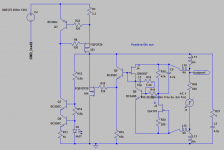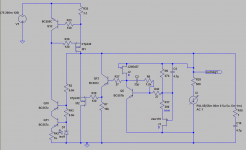Now using 0.5r + 4u7 on the zobel......🙂🙂🙂
There is a great improvement in speed...
I sense a difference between the several types of resistors used. (Some sound much clearer than others 🙂
Amazing results indeed !
Let us know your subjective opinions about resistors, are you using Obbligatos on the zobel?
Hi Merlin
Soundwise Obbligatos work very well in the zobel but I could not implement them successfully due to their big size. (In my build I got hum probably due to the big loop area created)
Apart from the hum, v12ff is much more detailed than v12 with EL in the output !!!
IMO the lower the output cap and the lower the resistor, the faster it gets !
I am very happy with 0.5r + 4.7u (small MKP from Mundorf)
I can not imagine why you should not get this incredible results yourself....
I wish I could convince you to try it again ! After the wonderfull job you have done with Salas riaa I believe it would be a total blast 🙂
Ricardo
Soundwise Obbligatos work very well in the zobel but I could not implement them successfully due to their big size. (In my build I got hum probably due to the big loop area created)
Apart from the hum, v12ff is much more detailed than v12 with EL in the output !!!
IMO the lower the output cap and the lower the resistor, the faster it gets !
I am very happy with 0.5r + 4.7u (small MKP from Mundorf)
I can not imagine why you should not get this incredible results yourself....
I wish I could convince you to try it again ! After the wonderfull job you have done with Salas riaa I believe it would be a total blast 🙂
Ricardo
If you want to try better resistor for zobel:
I have two Vishay S102K bulk metal foil 1% 2ppm
Or these two Caddock MP915 1%
I have two Vishay S102K bulk metal foil 1% 2ppm
An externally hosted image should be here but it was not working when we last tested it.
Or these two Caddock MP915 1%
An externally hosted image should be here but it was not working when we last tested it.
Yes, if the FQs won't present any argument, and you sink the error amp bjts. Watch it with the trimmer, nominal Vout is 56-57Vce...
Hi Klewis
Why are you using coils in the output ?
Merlin
Due to my layout, I need really small resistors.... I am afraid I will have hum issues with those.
Why are you using coils in the output ?
Merlin
Due to my layout, I need really small resistors.... I am afraid I will have hum issues with those.
Hi Klewis
Why are you using coils in the output ?
Merlin
1mm wire, 1 cm lenght = approx. 6nH
Inductance calculator
post2928.
Did the simulator indicate any difference in regulator performance when the cable inductances were added/subtracted?
I see you have +ve out and -ve out in the two diagrams.
You have omitted Zero Volts out in both diagrams.
The zero Volts is NOT at the ground symbol.
The junction of L12 to L13 is outposZeroVolts.
Did the simulator indicate any difference in regulator performance when the cable inductances were added/subtracted?
I see you have +ve out and -ve out in the two diagrams.
You have omitted Zero Volts out in both diagrams.
The zero Volts is NOT at the ground symbol.
The junction of L12 to L13 is outposZeroVolts.
1mm wire, 1 cm lenght = approx. 6nH
Inductance calculator
Acording to this, reducing the wire diameter increases it´s inductance !
Maybe that is why I have a subjectively bass heavier sound with higher diameter wire.
decreasing the wire diameter increases the gap between the wire and the return route.
That increased gap increases the inductance and decreases the capacitance.
That increased gap increases the inductance and decreases the capacitance.
decreasing the wire diameter increases the gap between the wire and the return route.
That increased gap increases the inductance and decreases the capacitance.
yes, the width of the space between the wires=gapHi Andrew
By gap do you mean the separation between (+) and (-) wires ?
Look at speaker cables as an example.
They are made big so you can easily see the different constructions and physical layout.
stranded wire, few cores, insulated and then parallel pair, or twisted pair or spaced apart pair.
fine stranded wire, many cores, insulated, then the three choices, parallel, twisted, big gap.
Now add in the odd balls, coaxial and plaited.
These all have a different physical/geometric shape.
They all have a different combination of capacitance and inductance.
That makes sence to me but what I did not realize before is that one straight wire alone can have inductance even if not twisted in a coil. That is what I can read here Inductance of a Straight Wire: A Calculator
Merlin
Due to my layout, I need really small resistors.... I am afraid I will have hum issues with those.
Both are small, are the pics (I take it very near the resistors) for sure you don't get hum with them, both have 8mm body & more or less 6mm between each leg.
- Status
- Not open for further replies.
- Home
- Amplifiers
- Power Supplies
- The simplistic Salas low voltage shunt regulator

